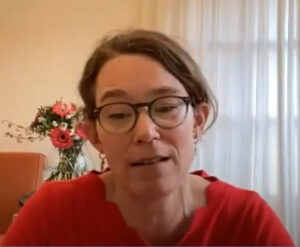Tactile transition – experiences shared by persons with acquired deafblindness
Kuurosokeus
1 helmi 2023
What is it like being diagnosed with a combined seeing and hearing impairment and gradually losing one or both of those senses? Is it just a loss? Or could it also entail a transition into the tactile sense? A transition that you might need a siesta from now and then. The Tactile Transition Project investigates this transition by interviewing people in the Nordics, the Netherlands and England about their own experiences of sensory changes.
The sensory system changes when persons with acquired deafblindness suffer progressive loss of sight and hearing. These changes are specifically noticeable in the tactile sense. But emphasis is often on the sensory loss and less on the sensory potential still available.
“How about a potential?”
 – I have Usher’s syndrome. For that reason, I have a loss. I was struggling with the fact that in the rehabilitation centres the focus was on the loss element. But I thought ”how about a potential?” says Femke Krijger, consultant and researcher at the Dutch Royal Visio.
– I have Usher’s syndrome. For that reason, I have a loss. I was struggling with the fact that in the rehabilitation centres the focus was on the loss element. But I thought ”how about a potential?” says Femke Krijger, consultant and researcher at the Dutch Royal Visio.
She is also part of the team working with the Tactile Transition Project and has interviewed persons living with acquired deafblindness going through changes in sense. The goal of the project is to accumulate new knowledge about acquired deafblindness, with the intent to apply this knowledge into practice.
Some of the results of the project were presented in a webinar which now is available on Youtube, Tactile Transition: Changes in Sensory Processing.
Emphasis on the sensory potential
The Tactile Transition Project is a uniquely designed, co-creation project studying the changes within the sensory system, specifically the tactile sense, of people with acquired deafblindness. Very little research has been done until now in this field, although it is widely accepted that changes take place with progressive loss of sight and hearing.
This research project aims to grow awareness of the sensory changes, focusing on the tactile sense, thereby offering new ground for discussion and further development of the support system for persons with acquired deafblindness.
Interviews in four countries
The project has gathered many stories from lived experience of persons with acquired deafblindness in four different focus groups in four countries.
The participants where a mix of genders, between 28 and 70 in age. There was also a mix of languages. Some participants used sign language, tactile sign language or spoken language.
“Feel the measuring cup with my fingers”
After analysing the stories a research framework of reference was developed, based on three validated scientific models, focussing on different aspects of the research topic.
“When I need 50 millilitres of water for example, then I feel the marks of my measuring cup with my fingers and can feel how far it is filled with water. Like this, I can measure the amount. You develop these kinds of tricks.” says one of the interviewees in the project.
Mapping these transitions, or developments of the use of the tactile sense is one of the research models of the Tactile Transition project.
Educating the surrounding
Although the degree of sight and hearing loss is individual, many persons with acquired deafblindness experience similar challenges when it comes to dealing with the surrounding. Often the disability does not show, and the gradual change is hard for people to understand. Many of the participants in the focus groups stressed the energy and time they have to spend on getting the surrounding to understand their impairment.
“I know I have to educate my surroundings. Friends and other people that I may not see very often. I would like them to tap me on the shoulder on the side where they are actually standing. And say ‘Hello, it’s so and so.’ Say their name, so I know who it is. It’s so easy for people to say Hi and say MY name and then they stand around waiting for me to figure out who it is. Or the famous question Can you see who it is?”
In need of a siesta
“The focus allows you to perceive a lot but costs a tremendous amount of energy. Therefore, I decide every afternoon that I did enough for that day, consciously. Then I put off my hearing aids. Remove my glasses and doze off for at bit. It’s the easiest way to do so, but the schedule of my day doesn’t fit with most schedules of others. A siesta, like in the Mediterranean countries would be best for me.”
This described by one of the participants is what the researchers term fatigue, something that most persons with acquired deafblindness experience. The transition insenses takes lots of energy and often make the person exhausted and tired in situations with an overload of sensory input.
The project will result in a report to be published next year.
